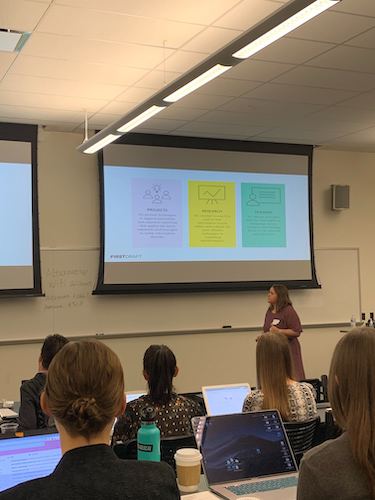First Draft teaches journalists how to avoid amplifying misinformation
Claire Wardle stood in front of a lecture hall filled with local journalists, smiling while they struggled to write a headline without amplifying the misinformation they were trying to correct.
She wasn’t the only one smirking. A student journalist myself, I watched amused as veteran journalists struggle to find the right wording, too. Turns out it’s harder than they thought.
First Draft visited the Walter Cronkite School of Journalism and Mass Communication on Jan. 31 as part of a national tour to teach local journalists about practices to stop the spread of misinformation. Wardle, the nonprofit’s co-founder, presented alongside research reporter Shaydanay Urbani.
“It’s really important that people are being thoughtful about how they report on social media and how they report on misinformation and taking into account the editorial standards in their newsroom related to those topics,” Urbani said.

First Draft Co-founder Claire Wardle, Ph.D., visits the Cronkite School Jan. 31.
Professional and student journalists in broadcasting and print media, as well as journalism educators, attended the free, all-day event. In the morning, First Draft hosted a live simulation that exposed journalists to the real-time effects of online attacks and disinformation. The group then learned about verification tools, online newsgathering and headline techniques to better prepare for the upcoming election.
Cronkite student journalist Farah Eltohamy said she’s always been scared of the prospect of misinformation. She’s seen its effects, too — attacks on a free press and loss of trust in the media — dating back to the 2016 election.
“I was in high school back then. I thought, ‘This doesn’t matter to me,’” Eltohamy said. “But now being a part of the press, I feel like I should do my due diligence to make sure none of this stuff explodes like it did in 2016.”
Now, she expects to use what she learned in her Cronkite News 2020 election beat. “So far, I haven’t been focused on ‘hashtag combat misinformation.’ But I’m definitely going to be more concerned heading into November with the election,” Eltohamy said.
Veteran journalists like Joe Dana added a few tools to their arsenal, too. The investigative reporter for 12 News, Phoenix’s NBC affiliate, said he’s been concerned about the backfire effect — when news outlets correct misinformation, but viewers still believe the incorrect information.
“We’ve had this dilemma come up a few times over the past couple of years,” Dana said. “You have something out there that is unverified, a conspiracy and it’s gaining traction on social media. It’s being forwarded and shared and maybe it even gets mentioned by a cable news channel. And we ask ourselves, ‘Do we want to give this play?’”
It’s a question some journalists ask themselves quite often.
“By repeating falsehoods to correct them, you risk giving those falsehoods more oxygen. So you have to decide what the tipping point is in your market, in your community,” Dana said.
First Draft’s presenters also mentioned how evergreen content, such as reporting on the lower crime rate of immigrants, helps to stamp out misinformation. Wardle said this helps protect marginalized communities who face prejudice when rumors and misinformation spread.
How else would you know that immigrants have a lower crime rate than America’s general population?
BrieAnna Frank, a reporter for the Arizona Republic, said she was happy she received this information at the beginning of her career so she can be proactive about stopping misinformation.
Frank was in college during the 2016 election, and said she remembers how rumors, conspiracy theories and misinformation thrived.
“[Misinformation] is not just an issue starting in 2020; it’s been an issue for a long time now,” Frank said. “Every opportunity to learn is great, but I would prefer to learn about these dangerous things that journalists can do unknowingly at the start of my career so I can prevent myself from making those same mistakes.”
Urbani said it was great to see local news reporters come to the training, but what would be more impactful is having people at the top of newsrooms — the managing and social media editors, specifically — to help make the best practices a standard in journalism.
“It’s one thing for a couple of reporters in a newsroom to be thinking about editorial standards and how to verify and monitor social media safely and ethically,” Urbani said. “But it totally changes things when you have buy in at the top.”
For more information about the remaining trainings, or to request one, visit First Draft’s website.
